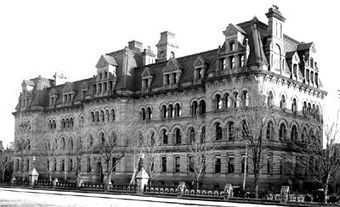Public-Service Unions
The public sector is highly unionized in Canada. Approximately 80% of those public-sector employees eligible for collective bargaining are covered by collective agreements, compared with only 25% in the private sector.
Most municipal and health care employees belong to the 460 000-member CANADIAN UNION OF PUBLIC EMPLOYEES (CUPE), and have bargaining rights similar to those in the private sector. However, since the early 1980s a number of provincial governments have restricted these rights. Health-care workers in some provinces are denied the right to strike.
Provincial employees, largely represented by affiliates of the 300 000-member National Union of Public and General Employees, are covered by more restrictive legislation. Most school, health-care and social-service employees bargain with a variety of boards and agencies that primarily administer provincial-government monies. In recent years, however, provincial governments have become more directly involved in collective bargaining in the health and education sectors. New Brunswick public-sector unions bargain directly with the province. In Québec a coalition of public-sector unions representing members of the CONFEDERATION OF NATIONAL TRADE UNIONS, the Québec Federation of Labour and the Québec Teachers' Corporation bargains directly with the province.
Most federal government employees belong to the 150 000-member Public Service Alliance of Canada, and have had bargaining rights since passage of the 1967 Public Service Staff Relations Act. This Act, however, severely limits the provisions that unions may negotiate. In the 1990s the federal government has virtually frozen COLLECTIVE BARGAINING. The smaller Canadian Union of Postal Workers (45 000 members) is considered the most militant (see POSTAL STRIKES, CUPW) and has bargained such breakthroughs as paid maternity leave, premium pay for weekend work and the right to bargain on technological change.
All of these public-sector unions have evolved from docile employee associations into genuine trade unions. Almost all of these unions, except the CNTU and the QTC, are affiliated with the CANADIAN LABOUR CONGRESS, where public-service employees now make up more than half the membership. Professional unions in the public sector - eg, nurses, teachers, academics, engineers - have largely remained independent. But even these groups have recently become militant and have frequently struck. Since 1996 several teacher and nurses unions have affiliated with the CLC.
Nurses and teachers in Canada bargain collective agreements on a province-wide basis. Most Canadian university academics, members of the Canadian Association of University Teachers (40 collective agreements, 22 000 members) bargain agreements directly with their employers.
Great expansion occurred in public-sector programs and services from 1965 to 1975, and a tremendous upsurge in union membership allowed many federal and provincial government employees to obtain limited bargaining rights. After 1975, limited economic growth resulted in cutbacks in many government programs. Bargaining rights were curtailed by wage-control legislation and limitations on the right to strike. Employees designated "essential" were prohibited from striking, and others were subjected to special legislation to terminate their legal strikes. The result was a sharp increase in public-sector strikes. Several union leaders were jailed during this period for defying back-to-work legislation. In recent years it has become increasingly difficult for unions to defend their members.
Up to 1982, public-employee unions faced a choice: to revert to being benevolent associations, playing the limited role that they had prior to the advent of collective bargaining, or to become militant political organizations in order to win back the bargaining rights they enjoyed in the 1965-75 period. After 1982, repressive legislation and huge services cutbacks forced public-sector unions to take the militant route, eg, the Operation SOLIDARITY strikes in BC in the autumn of 1983, the Newfoundland public-sector strikes of 1986, the 1991 strike of the Public Service Alliance of Canada and the 1996 strike of the Ontario Public Service Employees Union.
The delivery of public services underwent major changes in the 1990s. Deregulation, privatization, service cutbacks, wage freezes and restructuring have all resulted in strained relations between public-sector employees and their unions. These factors have also changed the composition of the membership of public-sector unions. For example, 55% of CUPE members are women and, of the total membership, 25% part-time employees. As a result, most public-service unions have joined together in coalitions of community groups and social justice groups to maintain adequate levels of public services. In the 1990s, public-sector unions are finding it increasingly difficult to negotiate collective agreements with employers who are also legislators. Governments which have not been successful in negotiating cutbacks with their unions have simply reverted to legislating those provisions by law.

 Share on Facebook
Share on Facebook Share on X
Share on X Share by Email
Share by Email Share on Google Classroom
Share on Google Classroom

